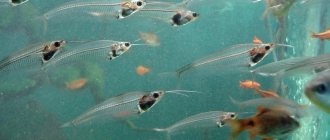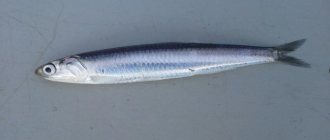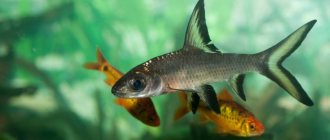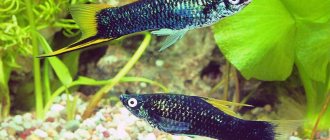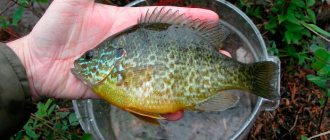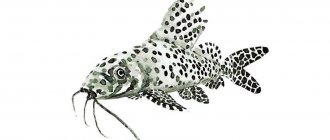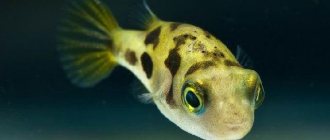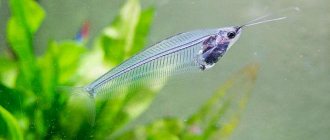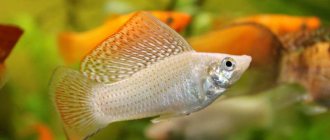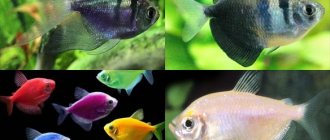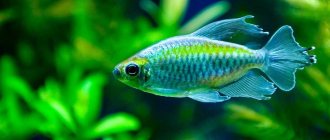White-bordered Apteronotus (lat. Apteronotus albifrons), or as it is more often called, the black knife, is one of the most unusual freshwater fish that hobbyists keep in aquariums.
They love her because she is beautiful, interesting in behavior and extremely unusual. In their homeland, in the Amazon rainforest, local tribes believe that the knife in fish is inhabited by the spirits of ancestors after death, so it is considered sacred.
Although they can grow quite large, around 40 cm, they remain very graceful.
Somewhat shy by nature, apteronotus adapt over time and begin to behave more boldly, even to the point of feeding from hands.
Habitat in nature
Apteronotus albifrons was first described by Carl Linnaeus in 1766. It lives in South America, in the Amazon and its tributaries. The scientific name is Apteronotus white-bordered, but more often it is called black knife. The name comes from English - Black Ghost Knifefish.
In nature, it lives in places with gentle currents and a sandy bottom, migrating to flooded mangrove forests during the rainy season.
Like most fish of its species, it loves densely overgrown places with lots of hiding places. In the Amazon, the places where Apteronotus lives are poorly lit and it has very poor eyesight.
To compensate for weak vision, the white-bordered one produces a weak electric field around itself, with the help of which it detects movement and objects. The field helps to hunt and navigate, but in addition, with the help of electricity, Apteronotus communicates with its own kind.
Black knives are nocturnal predators that hunt insects, larvae, worms and small fish in rivers.
For a long time, all apteronothus available for sale were exported from South America, mainly Brazil. But in recent years they have begun to be successfully bred in captivity, mainly in Southeast Asia, and the pressure on the wild population has dropped significantly.
How to breed
Breeding this fish at home is not an easy task. A special spawning water tank is required. Suitable volume - 150 l. Two males and one female of Apteronotus are placed in it. It is important that the individuals are sexually mature. They reach sexual maturity at 1.5 years.
For successful spawning, the owner of the aquarium must depict the rainy season in the tropics. First, he removes most of the water from the aquarium, leaving about 10-20 cm of water. This amount is well filtered. It is recommended to use a peat filter. There must be a sprayer that creates a stream of water. The temperature should be at the same level of +25 degrees. Every day, settled, distilled water is added to the tank.
Video: Reproduction of knife fish
If spawning has occurred, the female can lay up to five thousand eggs. They need to be separated from adults immediately. The vessel with caviar should have 10-15 cm of water, dim lighting. After 3-4 days the fry will appear. As soon as the owner sees the babies, he should change some of the water to fresh, oxygenated water. The water is changed daily throughout the month.
Fish knives grow quickly. After 4-5 weeks, the size of the fry will be 4-6 cm. They usually feed on zooplankton. After a month or a little more, the young individuals will begin to look for places where they can hide. Clumsy sticks, pipes, and plants are placed in a small aquarium for the comfort of the fry.
According to aquarists, the knife fish is a very grateful inhabitant of the home aquarium. She knows how to recognize the owner. Despite the ominous appearance, this is a calm, affectionate fish. The owner can pet her without any problems.
Description
The black knife can grow up to 50 cm and live up to 15 years. The body is flat and elongated. There are no dorsal or ventral fins; the anal fins extend along the entire body to the very tail.
Constant wave-like movements of the anal fin give Apteronotus a special gracefulness. Although they look a little awkward, their electric navigation system and long anal fin allow them to move very gracefully in any direction.
True to its name, Apteronotus is jet black, only on the head there is a white stripe that also runs along the back. Also two vertical white stripes on the tail.
Diseases
The most common disease of black prince fish is ichthyophthyriosis or white spot disease. It occurs due to the absence of scales on the body. Ichthyophthyriosis is caused by parasitic ciliated ciliates.
Symptoms of the disease:
- The appearance of small tubercles.
- The anal fin loses its beauty and becomes frayed and stuck together.
- The fish moves slowly.
- The fish's body is swollen.
To select a drug for treatment, consult your veterinarian.
A more rare disease is acidosis, which occurs due to low acidity of water. The fish are slow, lethargic, and white spots appear on the body. Acidity is increased by baking soda.
Difficulty in content
Recommended for experienced aquarists.
Since the black knife has no scales, it is very sensitive to diseases and the content of medicinal drugs in the water. It is recommended to install an external filter with a UV sterilizer, which will reduce the chance of developing the disease.
The fish is also sensitive to water parameters and their changes. Like many similar fish, Apteronotus is timid and indecisive, especially in a new aquarium.
Another difficulty is that this is a nocturnal predator, and it needs to be fed at night or at sunset.
Compatibility
Despite its docile and easy-going disposition, the knife fish exhibits poor compatibility with many phenotypes. Apteronotus mistakes small fish for food and readily eats them, while bright and active large fish cause discomfort to the apteronotus itself. You cannot choose the following representatives of the fish world as neighbors to black knives:
- Small fish: guppies, neons, cardinals and others.
- Large and aggressive representatives prone to fights.
- Bright and active fish, since their colors and constant energetic movements will frighten apterotonus.
Apteronotus shows the best compatibility with plecostomus, shark tank, stingray, pterygoplicht and kissing gourami.
Interesting fact: black knives are aggressive towards fish of their own species.
Feeding
Black knives are predatory fish. In nature, activity occurs at night, when they hunt insects, worms, snails and small fish.
In the aquarium they eat live or frozen food, for example, bloodworms, shrimp meat, brine shrimp or tubifex, fish fillets, you can also accustom them to various tablets and granules.
They will also hunt for small fish, which can be fed to the knives.
It is better to feed in the evening or at night, but as they get used to it, they can also feed during the day, even from their hands.
Reviews
Aquarists like to keep these black pets in the aquarium, they add elegance and beauty to the aquarium. But some note that caring for them is somewhat difficult, especially when breeding. And also some breeders are not happy that the pet is constantly out of sight, often hiding, and you can only enjoy its beauty temporarily.
Keeping in an aquarium
They spend most of their time closer to the bottom. The adult black knife is a large fish that requires a large aquarium. It is better to keep in aquariums of 400 liters or more.
A powerful external filter is required, with a UV sterilizer included. The fish produce a lot of waste, eat protein foods and are sensitive to water quality. Using such a filter will help solve many problems, if you forgot to remove leftover food, for example.
The soil is sand or fine gravel. It is important that there are many secluded places and shelters where Apteronotus white-bordered can hide during the day.
Some aquarists use clear tubes where the fish feel safe but still visible. They will spend most of the day in hiding.
It is advisable to have floating plants to create twilight and create a medium-strong current in the aquarium.
Water parameters: temperature from 23 to 28 °C, pH: 6.0-8.0, 5 - 19 dGH.
Exotic feature of knife fish
The absence of vision is successfully replaced by the organization of a weak electric field in a diameter of 7 cm. Moreover, the tail fin acts as its generator, and the entire body, covered with tubercles sensitive to electricity, acts as a kind of antenna. Fish and insects swimming by cause certain disturbances and fluctuations in the electric field created around the predator. Information about the parameters of a potential victim is sent to every part of the knife’s body, forcing the fish to react with lightning speed, absorbing suitable food. The device helps the predator to navigate perfectly in muddy bottom water day and night. However, the impulses are weak enough to harm surrounding fish or humans.
What does a fish knife look like?
Breeding
For reproduction you need an aquarium of 400 liters. For spawning it is necessary to place one male and two or three females.
After pair formation, the remaining females must be removed. Give the couple food high in protein. Water temperature - 27°C, pH 6.7. The pair spawns at night, on the ground, and it is important to observe every morning to see if spawning has occurred.
After spawning, the female needs to be removed, and the male remains - guarding the eggs and fanning them with his fins. As a rule, the fry hatches on the third day, after which the male can also be removed.
After the fry hatches, it feeds for two days from the yolk sac, and you can start feeding on the third day.
Starter food is ciliates. On the tenth day, you can transfer the fry to Artemia nauplii, feeding three times a day. After a while, the fry can begin to be fed with chopped tubifex; it is important to feed in small portions and often.
What does knife fish eat?
The aquarium knife fish, like its wild representatives, belongs to the class of predators. When purchasing a specimen for keeping, it is recommended to carefully select neighbors so that they do not become food for the black knife:
- Small and nimble guppies and neons, which the carnivorous knife will begin to hunt, are not suitable;
- you should not choose neighbors who have a pugnacious character and a tendency to eat the fins of other fish;
- better compatibility with fairly large individuals (shark baloo, stingray, pangasius, pterygoplicht and others of a similar nature);
- It is necessary to take into account that knives are too shy aquarium fish, despite their size and carnivory, so brightly colored, moving neighbors will create discomfort.
Knives prefer protein food. They eat tubifex and bloodworms well, live or frozen. They feast on pieces of squid and shrimp. They can eat a piece of raw beef or chicken.
When kept in captivity, the diet must be varied in order for the fish to feel good. But it is not recommended to overfeed pets in order to protect them from premature death. Feeding is done once a day, after darkening the lighting in order to bring the action as close as possible to natural conditions. If there are several black knives in the aquarium, then one individual should have at least 100 liters of water volume. Each male protects his territory, not allowing outsiders into it.
Disease Prevention
The absence of scales creates a risk of ichthyophthyriosis, the distinctive manifestations of which are the following symptoms:
- a rash of small tubercles (0.5 - 1.5 mm) in diameter appears on the skin;
- the fin on the belly becomes frayed and stuck together, which makes it difficult for the fish to move freely around the aquarium;
- The blade of the knife swells and becomes more rounded.
If you notice changes in fish behavior, you need to take immediate action:
- when choosing a suitable medicine, it is necessary to avoid compositions with zinc, which causes irreparable harm to the knife;
- It is not recommended to add salt to the water of the reservoir so that delicate fish do not die;
- You can use the malachite green preparation for treatment, having previously replaced at least a quarter of the water volume with fresh one. It is recommended to halve the dosage in comparison with the usual one (to 0.04 mg per liter of water), since the knives do not have protective scales.
- the medicine is added daily after replacing a quarter of the volume of the aquarium with a fresh aqueous composition.
Treatment is carried out until the rash completely disappears, adding another 2 days to consolidate the result. Maintaining a black knife requires some effort and skill, but decorating an aquarium for 10 years with this amazing fish is worth the effort.
Look at this amazing fish.
AdminAuthor of the article
Did you like the article?
Share with your friends:
Varieties and their appearance
Black
The fish Apteronotus albifrons can reach a length of 50 cm. They are distinguished by a black-charcoal body color, a white spot on the head and light stripes located near the base of the caudal fin. Black knife fish get along well with representatives of other species - cichlids, gouramis, chain catfish, but show aggression towards their relatives. Given this feature, only one individual should be kept in one aquarium.
Brown
Outwardly they resemble black knives, but differ in coffee coloring and a white edging along the back. Sometimes these fish are called "longnose" because they have a pointed nose.
Unlike black knives, they are more timid and susceptible to stress. The fish spend most of their time at the bottom, hiding in shelter, and do not try to rise to the surface. Like all knife fish, they have poor eyesight, so shelters made of transparent material can be placed in the aquarium. Fish are prone to fungal diseases, so they are not recommended for beginner aquarists.
Green
The green, or glass knife, is one of the smallest representatives of the species. Its length does not exceed 30 cm. The fish received its name for its translucent body with a greenish tint. In young individuals, skeletal bones and blood vessels are clearly visible. Over time, the body loses transparency. When surrounded by representatives of another species, it is quite shy. Feels free in a pack. When kept in groups, fish hunt together, generating a common electric field. In a multi-species aquarium, it gets along well with barbs, shellfish, and tetras.
African
In natural conditions it lives in West Africa, preferring bodies of water with slow currents. The fish is widespread in the rivers of Togo, Liberia, Sierra Leone, and Lake Chad. During the period of active growth, it is an active predator that is distinguished by its endurance.
The fish is suitable for breeding for beginners. The length of an adult reaches 20-30 cm. The body shape resembles a knife blade. The dorsal fin is absent, the anal fin stretches along the abdomen and goes into the tail. The fish has large eyes. The olfactory organs are well developed. The large swim bladder allows them to rise to the surface and breathe air.
The main diet consists of live food. The fish practically do not eat pellets and flakes. Fish have a pugnacious nature, so they should not be kept with small and peaceful species.
Ocellated Indian
The Indian eyed knife (also known as chitala ornata or chitala knife) is found in the rivers of Thailand, Sumatra and Malaysia. This is the most striking representative of knives. In the wild, an adult Indian knife can reach a length of one meter. The fish has a massive, slightly curved body covered with small scales. The color is silver, with a metallic sheen. The fish has quite expressive eyes and a large mouth. The caudal, anal and pectoral fins are connected into a single border, which stretches from below along the entire body. The dorsal fin looks like a feather. Along the middle line there is a pattern in the form of a strip of circles of a golden or whitish-gray hue.
